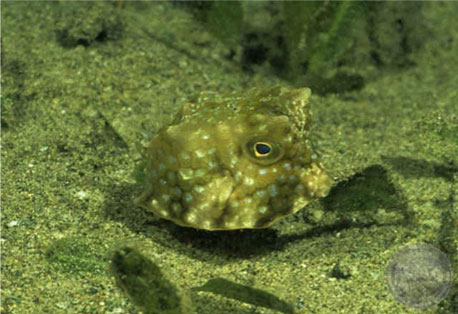Cowfish Information

Cowfish are a marine fish that belong to the order Tetraodontiformes and the family Ostraciidae. They are sometimes considered a type of boxfish, similarly to trunkfish. Unlike trunkfish, cowfish have head spines that look like horns protruding from the front of their head. Cowfish have two skeletons, including an exterior bony carapace and a reduced interior system. The outer bony carapaces are triangular bony boxes composed of fused hexagonal dermal plates. Cowfish may grow to be up to 45-48 cm in length. Cowfish lack both pelvic fins and pelvic bones, and their entire body is inflexible. Because of their stiffer body, they utilize the ostraciiform swimming method where they propel themselves by undulating their tiny fins and the tip of their tail. While slow, they can turn on a dime and dart into secluded overhangs and holes for safety.
Cowfish are reef and rock dwelling fish tht inhabit the Atlantic Ocean, the Red Sea, Pacific Ocean and Indian Ocean. Their residence may differ by species though. Scrawled cowfish are more often found in the Atlantic Ocean, while longhorn cowfish are spotted from Japan to Australia. Scrawled and honeycomb cowfish are both shallow water denizens that usually are found only as deep as 80 meters. Divers are more likely to spot scrawled cowfish out in the open rather than the shyer honeycomb cowfish. Cowfish can be territorial, but certain species may coexist with other non-aggressive species of fish. Scrawled cowfish are generally solitary, whereas honeycomb cowfish school in groups of three with a male and his harem. Cowfish diet consists of invertebrates and crustaceans. They can feed off of brine shrimp, worms and frozen food in captivity.
Cowfish will secrete a mucus or slime from their skin that helps to protect them against parasites and infections. The mucus helps these slower swimmers move a little faster through the water too. For some species, the slime is also fed to their young. When stressed, cowfish can release a poisonous toxin from their skin called ostracitoxin, which is poisonous to both predators and other cowfish. Cowfish will first rely on camouflage and stillness to avoid the eyes of predators though. They can change their colors as well to better camouflage themselves. A cowfish may take to burying itself in the sand for long periods of time to avoid detection. The toxin they have is usually a last resort. In terms of endangered species, cowfish are of least concern with a seemingly stable population.
